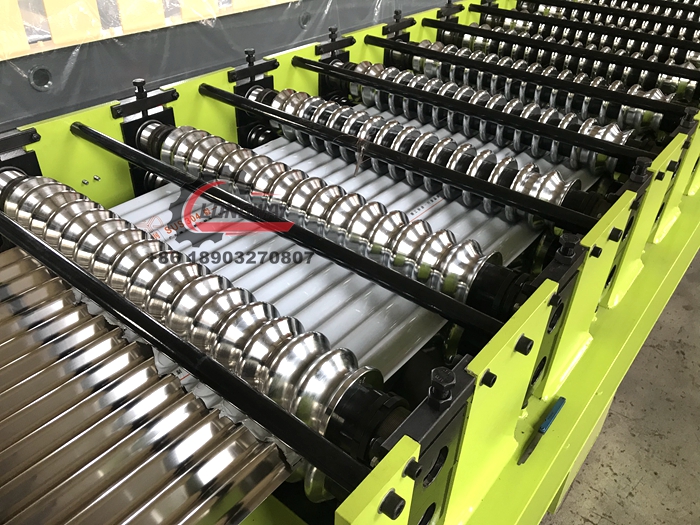C-Section Frame Roll Forming Equipment Manufacturers and Their Innovations
The Evolution and Significance of C-Section C-Frame Roll Forming Machines in Modern Manufacturing
In today’s fast-paced manufacturing environment, efficiency and precision are paramount. The design and production of structural components, especially in industries such as construction, automotive, and manufacturing itself, have seen significant advancements. One of the most crucial innovations in this realm has been the development of C-section C-frame roll forming machines.
Understanding C-Frame Roll Forming Machines
Roll forming is a continuous bending operation in which a long strip of metal, typically coiled steel, is fed through a series of rollers. These rollers progressively shape the metal into the desired profile. The C-frame roll forming machine, specifically, is known for its structural rigidity and reliability. It is designed to handle heavier materials and can produce components with excellent dimensional accuracy.
C-section profiles are widely used in construction and manufacturing due to their flexibility in application. They can be seen in the frames of buildings, the structure of vehicles, and various types of equipment. The robustness of C-section profiles makes them ideal for load-bearing applications, which is why the demand for C-frame roll forming machines has been on the rise.
The Advantages of C-Frame Roll Forming
1. High Efficiency One of the primary advantages of C-frame roll forming machines is their ability to produce large quantities of uniform products quickly. This efficiency is vital for manufacturers looking to meet tight deadlines without compromising quality.
2. Precision Engineering These machines can achieve tight tolerances and consistent dimensions due to their advanced design. This precision is critical, especially in industries where fit and structural integrity are paramount.
3. Versatility C-frame roll forming machines can handle a variety of materials and can easily be adapted to produce different profiles. This versatility allows manufacturers to cater to various market needs without the need for significant changes in equipment.
4. Cost-Effectiveness Though initial investment in a roll forming machine may seem high, the longevity and low operational costs often result in significant savings in the long run. The reduced waste and minimal labor requirements further enhance this cost efficiency.
5. Minimal Waste Roll forming is a process that produces very little scrap material. The continuous nature of the process allows for optimal material usage, which is increasingly important in an environmentally conscious market.
The Process of C-Section Production
c section c frame roll forming machine factories

The production of C-sections using a C-frame roll forming machine involves several crucial steps
1. Material Preparation The process begins with a continuous coil of metal, which is fed into the machine.
2. Roll Forming The metal is passed through a series of rollers specifically designed to reform it into a C-profile. Each set of rollers is crafted to achieve a specific bend or angle, gradually shaping the metal over several passes.
3. Cutting to Length Once the desired C-section profile is achieved, the continuous run of material is cut to length based on the specifications required.
4. Quality Control After the C-sections are formed, they undergo stringent quality control checks to ensure they meet the required standards in terms of dimensions and structural integrity.
5. Finishing Finally, additional processes such as painting, galvanizing, or welding may be applied to enhance durability and aesthetics.
Industry Impact and Future Trends
The significance of C-section C-frame roll forming machines extends beyond mere production efficiency. They contribute to the overall performance of structures and products in various industries. As modern construction techniques evolve and the need for lightweight yet durable structures grows, the role of these machines becomes increasingly important.
Moreover, with advancements in technology, such as automation and IoT integration, C-frame roll forming machines are evolving to become even more efficient and user-friendly. Manufacturers are investing in smart technologies to monitor production processes in real time, ensuring high levels of precision and reducing downtime.
Conclusion
In conclusion, C-section C-frame roll forming machines represent a significant advancement in the manufacturing sector. Their ability to produce high-quality, consistent, and efficient profiles makes them indispensable in various industries. As technology continues to evolve, these machines will play a crucial role in shaping the future of manufacturing—building stronger, more reliable structures that meet the demands of tomorrow’s market. As we look ahead, the ongoing innovation in this field promises to enhance productivity and sustainability, reinforcing the importance of C-frame roll forming machines in modern manufacturing.
-
Roof Panel Machines: Buying Guide, Types, and PricingNewsJul.04, 2025
-
Purlin Machines: Types, Features, and Pricing GuideNewsJul.04, 2025
-
Metal Embossing Machines: Types, Applications, and Buying GuideNewsJul.04, 2025
-
Gutter Machines: Features, Types, and Cost BreakdownNewsJul.04, 2025
-
Cut to Length Line: Overview, Equipment, and Buying GuideNewsJul.04, 2025
-
Auto Stacker: Features, Applications, and Cost BreakdownNewsJul.04, 2025
-
Top Drywall Profile Machine Models for SaleNewsJun.05, 2025








